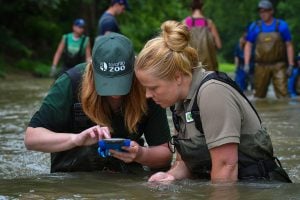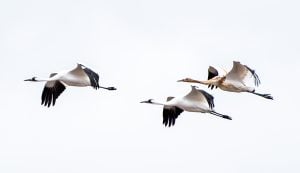
Environment
When it comes to conservation research, are zoos and aquariums doing enough?
A new study finds zoos and aquariums in Canada are publishing more peer-reviewed research, but there is still more to be done
- 1471 words
- 6 minutes
People & Culture
The CEO of the Toronto Zoo and Fellow of the Royal Canadian Geographical Society talks about the newborn red panda cub and how a single animal can make a difference

As a conservation educator, DeJong believes in connecting people to the natural world and says that efforts need to go beyond captivating photos and videos. Under the guidance of the North America Association of Zoos & Aquariums (AZA), the Toronto Zoo has been engaged with the Species Survival Plan® (SSP) which is working to secure genetically viable individuals that may be needed in the future if red panda populations decline is not reversed. In an exclusive interview with Canadian Geographic, DeJong shares his joy of welcoming a new red panda cub to the Toronto Zoo and explains how individual animals born in captivity can help their wild counterparts in Asia.
First of all, I will start with their status in the wild. Estimates point to 2,500 to 10,000 red pandas left in the wild, and their range is being consistently reduced. I wish we had a better narrative around what’s going on in the wild, but habitat loss is still a major issue, as it has been in other cases.
In North America, the AZA collaborates with accredited zoos and aquariums to manage species populations within the SSP. This program keeps track of each individual animal’s genetics, so we literally know their bloodlines, and this allows us to picture all of them working together as a larger population. Historically speaking, there were no connections between the animals in your zoo and the ones in the wild. We need to make sure that we have viable populations for decades to come, and if needed in the future, they may help repopulate wild red panda populations, but this is not the case yet.

Captive red pandas can play several roles to help their wild counterparts. It’s not enough to just capture them in videos and photos. We’re building our expertise to better understand these animals. This red panda cub is only our second litter at the Toronto Zoo in the past 25 years, so it’s important to understand well and support this species before we’re down to the last few.
Baby Spice, named to emulate his mother, Paprika (and serves my interest in the Spice Girls!) is doing incredibly well. I am pleased to share that Paprika has been doing all the work so far. That’s not always the case. Adira, who belonged to another red panda group, didn’t produce much milk after she had a baby two years ago, and our team had to intervene and bottle feed the youngster. Baby Spice is a big, chunky young little panda. We’re really happy to see him putting on weight, and mom is doing a great job. She’s feeling so good about it that she’s exiting her habitat periodically and leaving her baby unattended so we can get in and have a closer look at it.
I hope we won’t need any special procedures with Baby Spice. One of the best indicators of health is weight, just like with human babies. When mom steps outside to explore her habitat or to have a bite, our amazing team has a chance to lay hands on the baby. They will get the little male out and put him on a scale. What we’re looking for is continuous growth. Once he starts moving a bit more, we may see a flattening, but right now, building his fat reserves is key.
The wildlife care team does body inspections. If you could be there during a session with Paprika, you would be able to see that she works well with her trainers. They can ask her to present her front or to show a certain part of her body, so they can have a look at the entire animal. We’re looking to see if there are any lesions or sores. In certain environments, we would be wondering if there are ticks or mites or anything else that could impact the animal’s health. Our team knows how these animals are supposed to look, and they can watch for anything odd during visual inspections. So far, Paprika has done a fantastic job! She’s grooming her baby, keeping him clean, and of course, feeding him.
Keep tuned to our social media. We had a tremendous amount of public interest before, and we loved seeing how our community reacted. They have a strong sense of ownership of these animals. It’s important to build curiosity, so they are learning more about natural history and maybe taking some steps towards conservation action. Sometimes it will directly benefit red pandas, sometimes another species. One of the outcomes we’re looking for is for people to be mindful of the impact we make when we reach our hands into our pockets for our wallet.
In 2020, we saw an increase in traffic around the red pandas’ habitat when the youngster were out. We had a tremendous surge in membership too, between pandemic openings and closings, but it is hard to pinpoint why. Digitally, there’s no question that there was a huge interest, with many questions and comments arriving. These last few years have been challenging, so we’re pleased to provide another good story for our community.
Every animal at the zoo is someone’s favourite, and people develop deep relationships and follow an individual animal throughout their whole life. They follow it from infancy to adulthood and then to having their own youngsters. We love to see this kind of connection that is not just a moment in time.
We know the baby will be weaned in five months, but it will depend on how our team feels about it. How fast will Baby Spice develop its dexterity? It’s like those first days of school. Hopefully, we’ll see him starting to venture out into his habitat at around two and a half to three months. How comfortable are his mom and our team in providing him access to the entire habitat? If that little guy is climbing up a tree because his nails have developed, he needs to be able to find his way back down.
If you’re willing to learn more about our work, I encourage you to go to our website where we have an Adopt and Animal program. It supports the Red Panda Species Survival Program, which is part of our Toronto Zoo Wildlife Conservancy. I’m grateful to all the folks who are interested in animals and who are advocating for them. We need as many voices as we can to speak for the animals.
Are you passionate about Canadian geography?
You can support Canadian Geographic in 3 ways:

Environment
A new study finds zoos and aquariums in Canada are publishing more peer-reviewed research, but there is still more to be done

People & Culture
The story of how a critically endangered Indigenous language can be saved

Environment
The planet is in the midst of drastic biodiversity loss that some experts think may be the next great species die-off. How did we get here and what can be done about it?

Wildlife
The Vancouver Island marmot, burrowing owl, greater sage-grouse and northern leopard frog are thriving again thanks to the zoo’s efforts